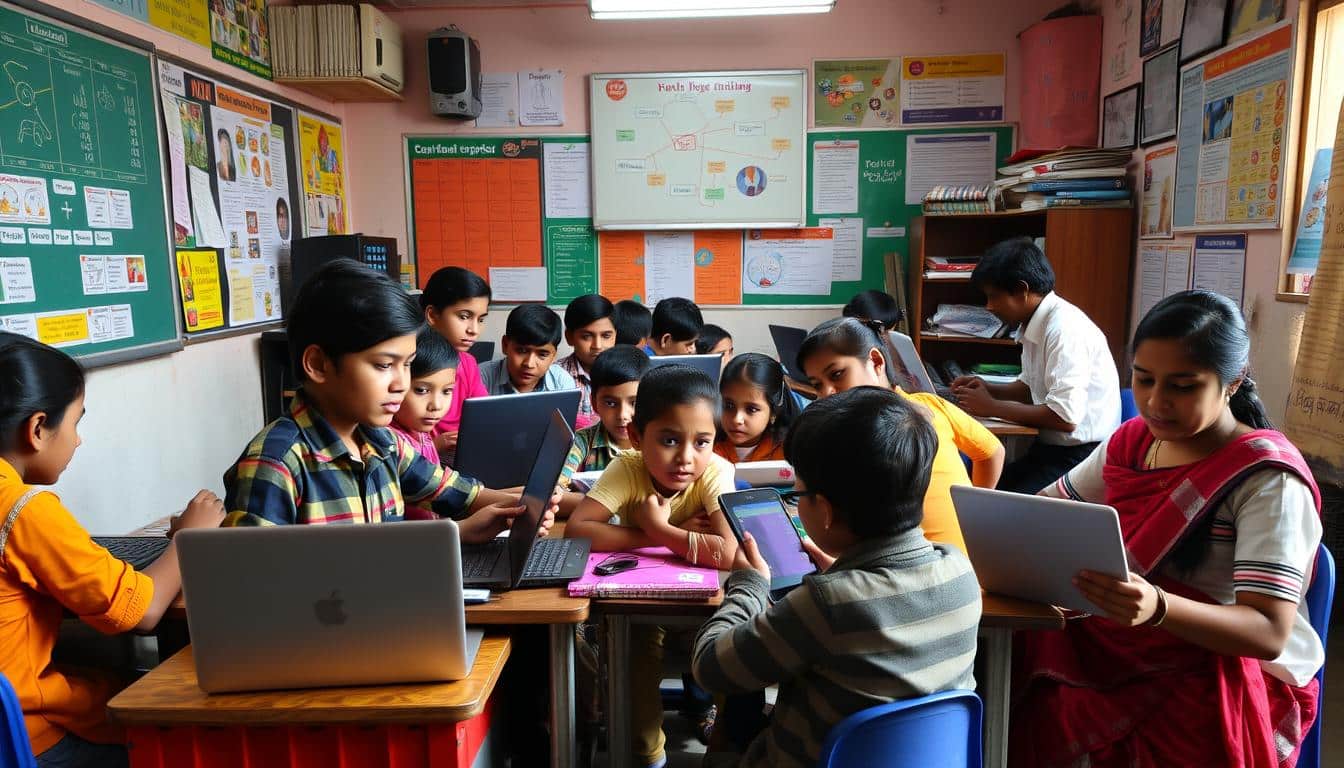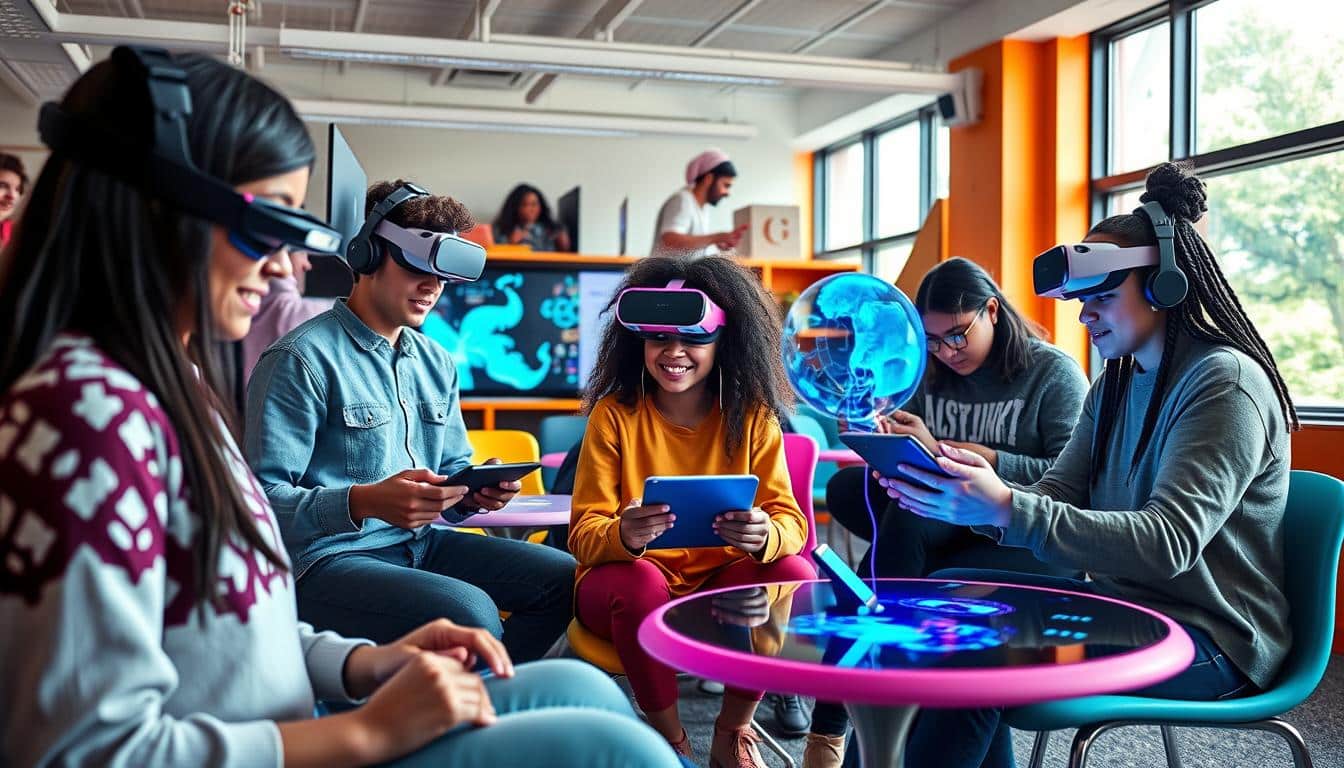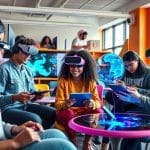Technology Impact on Education
In a transformative shift, over 300 million Indians now have internet access, catalyzing a digital revolution that is reshaping the educational terrain. The incorporation of technology into classrooms has not only elevated the quality of learning but has also broadened access to educational resources. This development empowers both students and educators across the nation. This article delves into the various dimensions through which technology is redefining the educational paradigm in the world’s largest democracy.

Key Takeaways
- The rise of digital learning platforms and virtual classrooms is expanding educational opportunities in India.
- Blended learning, which combines traditional and digital teaching methods, is gaining traction in the country.
- Enhancing digital literacy and integrating technology in teacher training are crucial for successful EdTech implementation.
- Educational apps and mobile learning are emerging as innovative trends that cater to the diverse needs of Indian students.
- The COVID-19 pandemic has accelerated the adoption of technology in Indian education, underscoring its pivotal role in the future of learning.
Introduction to Educational Technology
In the rapidly evolving digital landscape, the role of educational technology (EdTech) in transforming the learning experience has become increasingly prominent. The EdTech industry in India has witnessed remarkable growth, driven by innovative advancements that have revolutionized the way students engage with educational content and teachers deliver their lessons.
The Evolution of EdTech in India
The EdTech sector in India has undergone a significant transformation over the past decade. From the introduction of interactive whiteboards and learning management systems (LMS) to the proliferation of educational apps and virtual classrooms, the EdTech landscape has continuously expanded. This expansion caters to the diverse needs of students and educators alike. These advancements have not only enhanced the accessibility of educational resources but have also fostered a more engaging and personalized learning environment.
Benefits of Incorporating Technology in Learning
- Improved student engagement and retention
- Personalized learning experiences tailored to individual needs
- Enhanced access to a wide range of educational content and online resources
- Opportunity for collaborative learning and seamless communication between students and teachers
- Efficient data-driven decision-making and real-time feedback for educators
The integration of educational technology, edtech innovations, online resources, and educational software has transformed the educational landscape in India. It has paved the way for a more inclusive, engaging, and personalized learning experience for students across the country.
The Role of Technology in Education
The integration of technology in the education sector has profoundly transformed the learning landscape in India. It encompasses digital classrooms, online courses, and virtual learning environments, becoming a cornerstone of modern education. This section delves into the diverse ways technology empowers students, teachers, and educational institutions.
Technology’s incorporation in learning has significantly enhanced classroom dynamics. Digital classrooms are now equipped with interactive whiteboards, multimedia presentations, and educational software. These tools create a dynamic, immersive environment, promoting deeper understanding and active engagement among students.
The rise of online courses and virtual learning environments has also broadened education’s accessibility. These digital platforms enable students, particularly those in remote or underserved areas, to access quality educational content and resources at their convenience. This expansion significantly increases education’s reach in India.
“Technology has the power to transform education, making learning more personalized, interactive, and accessible for students across the country.”
As technology’s role in education continues to grow, educational institutions are adopting innovative solutions to improve the learning experience. From adaptive learning algorithms to virtual reality-based simulations, the integration of advanced technologies is redefining education’s future in India.

Virtual Classrooms and Online Learning
The educational landscape in India has undergone a significant transformation, with virtual classrooms and online learning at its forefront. These digital solutions have transformed how students interact with educational content, enabling remote and asynchronous learning. This shift has opened new avenues for educational access and engagement.
Learning Management Systems (LMS)
At the heart of this educational transformation are Learning Management Systems (LMS). These platforms offer a comprehensive array of tools for course creation, delivery, and management. They facilitate the integration of video lectures, interactive quizzes, discussion forums, and assignment submissions. This empowers educators to design personalized and engaging learning experiences for their students.
Interactive Learning Platforms
Interactive learning platforms complement LMS, enhancing virtual classroom engagement and collaboration. These platforms feature virtual whiteboards, live video conferencing, and real-time annotation capabilities. They enable seamless collaboration and idea exchange between students and teachers in a digital environment.
The rise of virtual classrooms and online learning has not only broadened educational access but also introduced personalized and adaptive learning opportunities. By harnessing these technologies, India’s education system is set to become more inclusive, flexible, and responsive to the varied needs of students.

| Feature | Learning Management Systems (LMS) | Interactive Learning Platforms |
|---|---|---|
| Course Creation | ✓ | ✓ |
| Video Lectures | ✓ | ✓ |
| Interactive Quizzes | ✓ | ✓ |
| Discussion Forums | ✓ | ✓ |
| Virtual Whiteboards | – | ✓ |
| Live Video Conferencing | – | ✓ |
| Real-time Annotation | – | ✓ |
Blended Learning: Combining Traditional and Digital Methods
In the evolving landscape of education, the concept of blended learning has emerged as a powerful approach. It seamlessly integrates traditional, face-to-face teaching methods with digital and interactive learning elements. This dynamic fusion harnesses the strengths of both conventional and technological approaches, creating a more engaging and effective learning experience for students.
The beauty of blended learning lies in its ability to leverage the advantages of various learning modalities. Traditional classroom instruction provides the personal touch and immediate feedback that many students thrive on. Meanwhile, digital resources offer boundless opportunities for personalized, self-paced, and digital literacy development.
By combining these elements, blended learning fosters a richer, more immersive educational environment. Students can engage with interactive multimedia, access a wealth of online resources, and collaborate with peers through virtual platforms. All this is done while benefiting from the guidance and support of their classroom teachers.
This holistic approach not only enhances the overall learning experience but also plays a crucial role in equipping students with the digital literacy skills necessary to navigate the increasingly technology-driven world. As the boundaries between traditional and digital learning continue to blur, blended learning emerges as a pivotal strategy. It prepares students for the challenges and opportunities of the future.
| Traditional Learning | Blended Learning |
|---|---|
| Face-to-face instruction | Combination of face-to-face and online learning |
| Textbooks and physical resources | Digital and interactive learning materials |
| Passive learning experiences | Engaging and personalized learning experiences |
| Limited access to information | Abundant access to a wealth of online resources |
“Blended learning is the future of education, combining the best of traditional and digital approaches to create a truly transformative learning experience.”
Digital Literacy and Skill Development
The advent of educational technology has profoundly reshaped the educational paradigm, underscoring the critical role of digital literacy and skill development. As technology permeates the classroom, students must acquire fundamental digital competencies to excel in the 21st-century knowledge economy.
Enhancing Digital Skills for Students
The digital era has introduced a new paradigm of educational opportunities, enabling students to harness a plethora of digital tools and resources to enrich their learning journey. From mastering coding and data analysis to creating multimedia content, the acquisition of digital skills empowers students to navigate the digital realm and confront intricate challenges.
- Coding and programming: Acquiring coding and programming skills enables students to decipher the language of technology, thereby enhancing their problem-solving and critical thinking capabilities.
- Data analysis and visualization: Developing proficiency in data analysis and visualization empowers students to decipher the vast expanse of information, uncovering insights and trends.
- Multimedia content creation: Encouraging students to create multimedia content, such as videos, presentations, and digital art, fosters their creativity and communication skills.
Teacher Training for Technology Integration
Concomitant with the development of digital skills for students, the effective integration of educational technology necessitates comprehensive teacher training. Educators are instrumental in harnessing digital tools and resources to enhance student learning outcomes. By equipping teachers with the requisite skills and knowledge to seamlessly integrate technology into their pedagogical practices, schools can ensure the optimal utilization of educational technology.
| Key Areas of Teacher Training | Objectives |
|---|---|
| Digital Literacy | Enhancing teachers’ proficiency in using digital tools and platforms to support their own professional development and classroom instruction. |
| Pedagogical Integration | Equipping teachers with strategies to effectively integrate technology into their teaching methods fosters engaging and interactive learning experiences. |
| Adaptive Instruction | Enabling teachers to utilize digital literacy and skill development tools to personalize and adapt instruction to meet the diverse needs of their students. |
By empowering both students and teachers with the necessary digital skills and technology integration capabilities, educational institutions can unlock the full potential of educational technology to revolutionize learning and equip the next generation for success in the digital age.
EdTech Innovations and Emerging Trends
The educational technology sector is undergoing a profound metamorphosis, driven by the rapid evolution of the educational landscape. This transformation is marked by the ascendance of educational apps and the widespread adoption of mobile learning solutions. These developments are fundamentally reshaping the manner in which students interact with and assimilate knowledge.
Educational Apps and Mobile Learning
The advent of smartphones and tablets has catalyzed the emergence of educational apps, offering learners personalized and mobile learning experiences. These edtech innovations boast a plethora of features, including interactive lessons, gamified content, and real-time feedback. Such attributes enhance the engagement and accessibility of educational content for students.
Mobile learning stands out as a pivotal innovation, enabling students to engage in learning at any time and from any location. Educational apps and mobile-optimized platforms facilitate access to educational materials, participation in virtual classes, and peer collaboration. This approach to education is characterized by its flexibility and personalized nature.
- Personalized learning paths tailored to individual needs
- Engaging and interactive content that enhances knowledge retention
- Seamless integration of mobile learning into the daily lives of students
- Opportunities for collaborative learning and peer-to-peer interaction
The EdTech sector’s ongoing evolution is redefining the educational paradigm, empowering both students and educators to harness the transformative power of technology-driven learning. These edtech innovations and educational apps are pivotal in shaping the future of education, fostering a more dynamic and technology-integrated learning environment.
Conclusion
The transformative impact of technology on India’s education sector is profound. This integration of educational technology (EdTech) has revolutionized the learning experience, empowering both students and teachers. The role of technology in education has become increasingly pivotal, with virtual classrooms, online learning platforms, blended teaching methods, and digital skill development at the forefront.
Embracing EdTech has opened new avenues for enhanced learning outcomes, improved accessibility, and personalized educational experiences. By fostering digital literacy and incorporating innovative technologies, India’s education system is poised to prepare the next generation for the digital future. However, the journey ahead requires a comprehensive approach to address ongoing challenges and ensure equitable distribution of these technological advancements across the nation.
As we move forward, it is crucial to continue investing in the development of robust EdTech infrastructure. Providing comprehensive training for teachers and nurturing a culture of digital innovation within the education ecosystem are essential. Only through a collaborative effort between policymakers, educators, and technology leaders can we unlock the true potential of educational technology. This will empower India’s students to thrive in the rapidly evolving digital landscape.
FAQ
What is the role of technology in education?
Technology is revolutionizing education in India, enhancing learning experiences and broadening access to knowledge. It integrates digital tools into classrooms and fosters virtual and blended learning models. This transformation is pivotal in shaping the future of education.
How has educational technology (EdTech) evolved in India?
The EdTech sector in India has seen rapid growth and innovation, transforming learning and teaching. Technology’s integration into education has brought numerous benefits, including enhanced engagement, personalized learning, and increased accessibility to educational resources.
What are the benefits of incorporating technology in learning?
Technology’s inclusion in learning offers several advantages, including increased engagement, personalized learning, and broader access to educational resources. Digital tools and platforms facilitate more interactive and immersive learning, making education more accessible and flexible for students.
How are virtual classrooms and online learning transforming education?
Virtual classrooms and online learning platforms, such as Learning Management Systems (LMS) and interactive platforms, are enabling remote and asynchronous learning. These digital solutions are expanding educational access and offering more flexible learning options for students.
What is the role of blended learning in education?
Blended learning combines traditional teaching methods with digital and online elements. It leverages the strengths of both traditional and digital learning, creating a more engaging and effective learning experience. This approach also fosters digital literacy.
How are digital literacy and skill development important in the context of educational technology?
The integration of technology in classrooms necessitates students to acquire essential digital skills, from coding to data analysis. Teacher training is critical to ensuring technology’s effective integration into learning. This enables educators to use digital tools and resources to enhance student outcomes.
What are the latest innovations and emerging trends in the EdTech industry?
The EdTech sector is witnessing a surge in educational apps and mobile learning solutions. These innovations provide students with personalized and accessible learning experiences. They are reshaping the educational landscape, making learning more engaging and effective.















